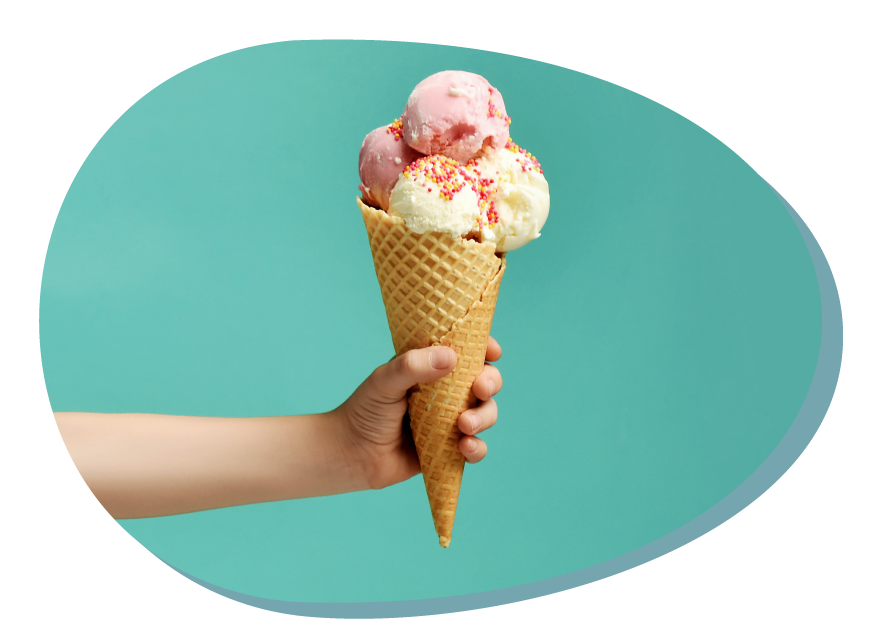Ice Cream in a bag
Language: English
Description
To make ice cream inside a bag
Scientific concept introduced
Liquid, solid, change of state, freeze, temperature.
Creative and critical thinking
To observe what happens in the bags.
Mathematical reasoning
Measuring the ingredients to make the ice cream. Follow instructions.
Scientific thinking
To observe, to ask questions.
Learning how to learn
Building self-confidence, feeling of selfefficacy in learning. Motivation to learn and engage
Additional
Hand-eye coordination, teamwork, Sharing ideas.
Ice Cream in a bag
Overall aims
- To progress in the knowledge and mastery of your body, in the movement and coordination, while realizing its possibilities.
- To observe and explore the immediate, natural and physical environment, with an attitude of curiosity and respect and gradually participate in social and cultural activities.
- To progress in the communication and expression in different contexts and situations of habitual communication through the different languages.
- To learn enjoying the learning process, thinking and creating, doing things the right way asking themselves how to do things, accept the critiques and build the knowledge in an organized way.
Vocabulary – keywords should be understood
- Free lactose milk
- Liquid state→ solid state
- Nutritional
- Healthy food/eating
Expected learning outcomes (operational aims)
- The boys and girls will explore the properties and changes of materials
- Children will be able to shape materials
STEM skills – to which the learning unit is related to
CORE STEM SKILLS
Critical and logical thinking:
- How can the mixture freeze without putting it in a freezer?
- Why do we need the salt for?
- What quantities do we need to make a little bit of ice cream?
- Why is the banana one of the basic ingredients?
- To analyze the different states (liquid and solid)
Processing data:
- To observe
- To follow instructions (steps and quantities)
Autonomous problem-solving:
- To use the cooking utensils to make the recipe
- Skills to put materials or ingredients inside others.
Creativity and collaboration:
- To experiment and have interest in doing the recipe
Communication:
- To be curious and make questions
- To ask for help if needed
Teamwork:
- To help each other
How is science involved in this activity?
The salt mixed with the ice makes the melting temperature drop, which makes the ice take longer to unfreeze. The salt gives enough time for the ice to freeze the ice cream and have its characteristic texture. This allows us to shake the ice bag long enough to make the ice cream mixture solidify/freeze. If we are more salt the melting temperature will drop even more, and the ice cream mixture will take less time to freeze.
ADDITIONAL SKILLS
–
Teaching methodologies/activity outline
- Step 1: Put the ice inside a big ziplock bag and crush it a little bit. (You will need quite a lot). Add the salt (generous amount).
- Step 2: Squash a banana with a fork (in this case, half a banana) and mix it with milk (approximately ¼ of a cup). The quantities will change according to the amount of ice cream that wants to be made.
- Step 3: You can add other ingredients to the mix and then pour the mix inside a tinier ziplock bag.
- Step 4: Put the tiny bag inside the ice bag, make it fit so it has ice all around.
- Step 5: Shake! The ice cream takes little time to be made (less than 5 minutes approximately), so be quick.
- Step 6: Put the ice cream in a bowl, and now it’s time to enjoy.
Assessment of learning
Observation of process and live feedback (formative)
Equipment and materials to be used in learning unit (tools, ingredients etc)
- Banana or other fruits. (also chocolate, nuts, spices…)
- Salt
- Ice
- Milk
- Fork
- Knife
- Spoon
- Two ziplock bags (A big one and a little one)
Kind of setting
Preferably: kitchen
References – source
No references
Ice Cream in a bag
1. Usefulness for STEM education – integrating content of different disciplines
Cross-curricular character of the resource

The range of S-T-E-M subjects included

The presentation of possibilities of including artistic activities (STEAM approach)

2. Expected learning outcomes
Consistency (links) with preschool core curriculum

Communicativeness of description

3. Methodology of teaching
Clarity, communicativeness of instructions for teachers

Meaningful learning – using practical life problems

Original idea

The level of ease in implementing the methodology to preschool age children

The level of ease in preparing necessary ingredients, materials and equipment needed

4. Sustainability
Ecological characteristics of materials/ results

Supporting healthy eating habits

Relation with local traditions of cooking (using local products)

Low ecological footprint

Possibilities of inclusion (respecting cultural diversity and food intolerances)

5. Class management
Using differentiated forms of work – individual, team work etc.

Individual work

Team work

Whole group
6. Time management

Short activity (10-15 minutes)

Medium activity (20-30 minutes)

Long activity (1 hour or more)

Very long activity (1 day or more)
PDF: https://www.printfriendly.com/p/g/yWJLb3

